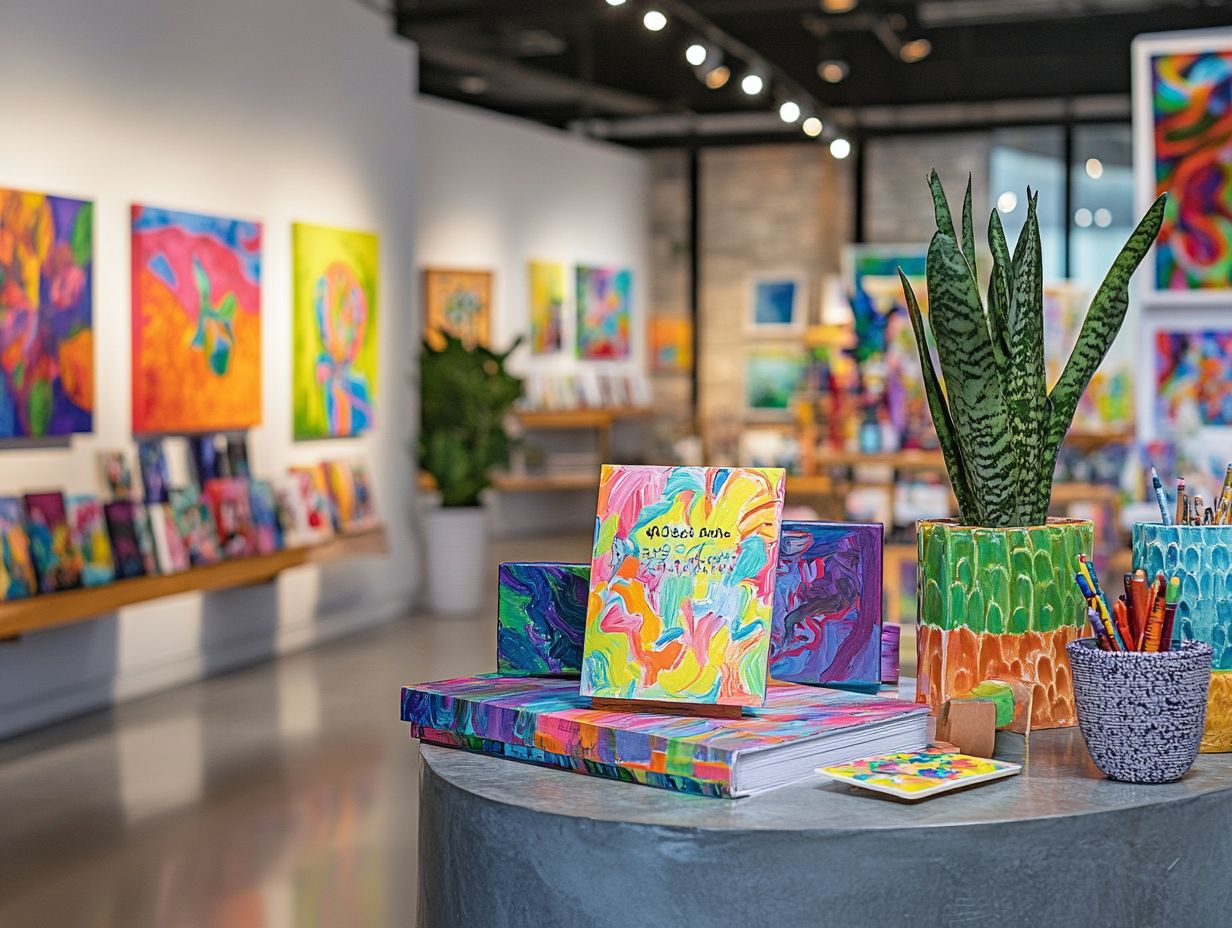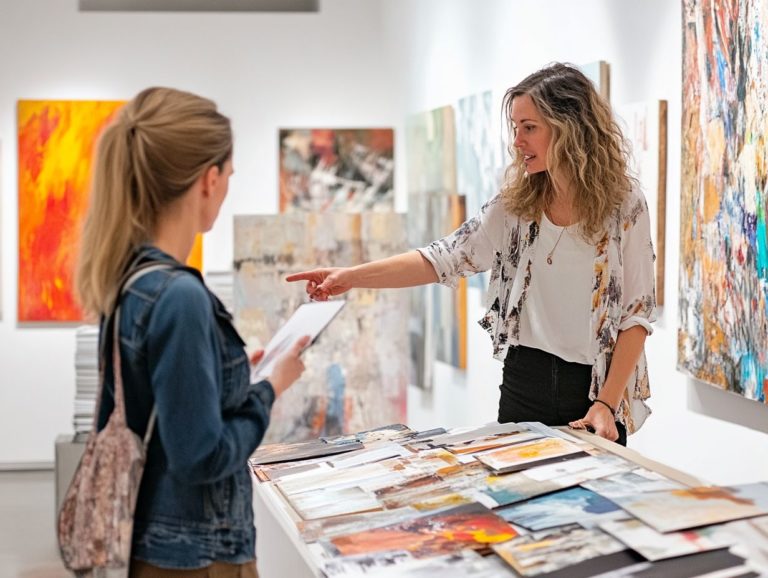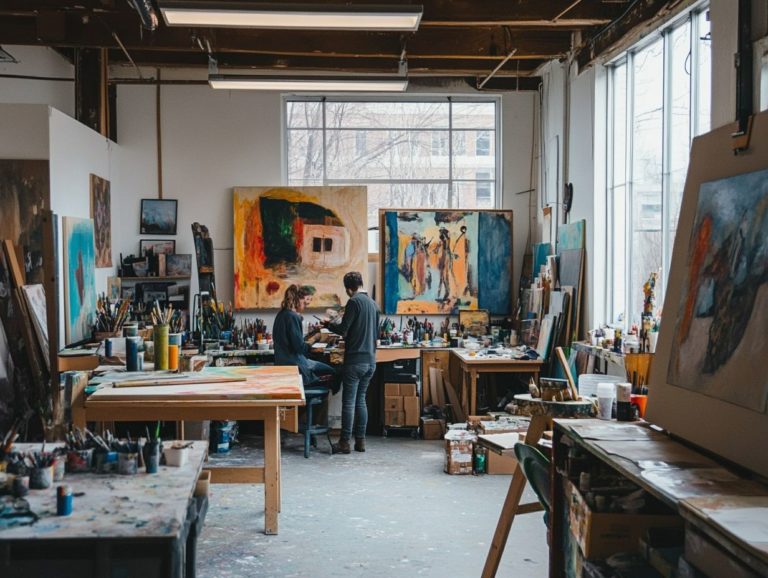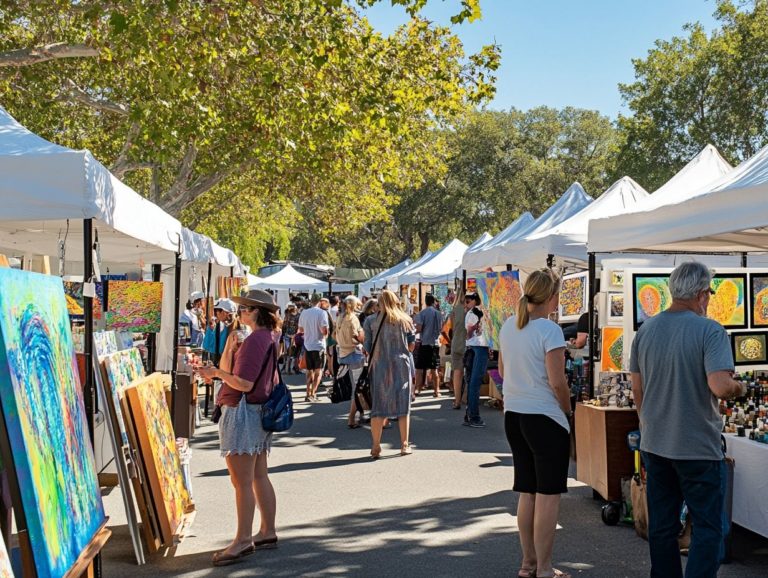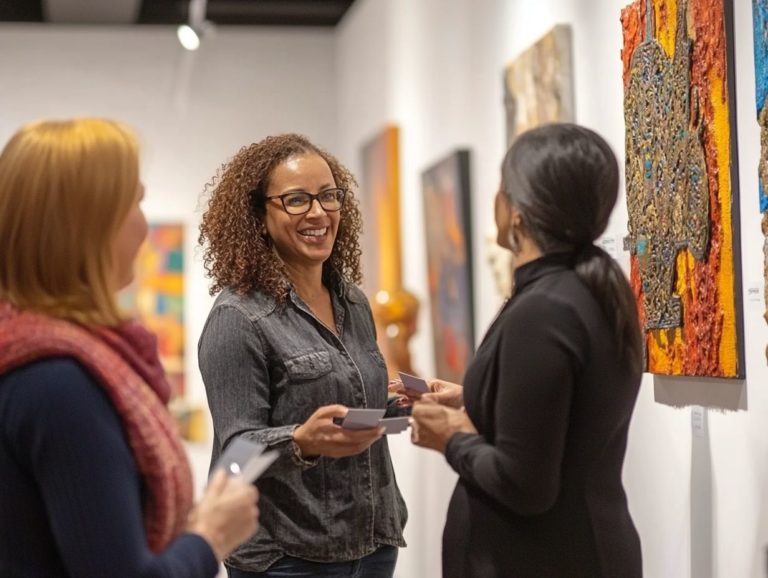10 Inspirational Quotes for Art Collectors
Art is a profound journey, rich with emotion and discovery. For you, collecting art can become a meaningful expression of that journey. Let s explore ten inspirational quotes that resonate deeply with art collectors, shedding light on the unique relationship between the observer, the creator, and the artwork itself.
You ll delve into the various types of collectors, the fun and challenges of starting your art collection, and how to navigate this vibrant world. Don t miss out on the chance to connect with art like never before!
Discover the fulfilling aspects of art collecting and the invaluable contributions you make to the art community.
Contents
- Key Takeaways:
- 1. “Art is not what you see, but what you make others see.” – Edgar Degas
- 2. “The purpose of art is to make the invisible visible.” – Paul Klee
- 3. “Every artist was first an amateur.” – Ralph Waldo Emerson
- 4. “Art is not a handicraft; it is the transmission of feeling the artist has experienced.” – Leo Tolstoy
- 5. “Art is not a thing; it is a way.” – Elbert Hubbard
- 6. “The aim of art is to represent not the outward appearance of things, but their inward significance.” – Aristotle
- 7. “Art is a journey of discovery.” – Marina Abramovic
- 8. “Art enables us to find ourselves and lose ourselves at the same time.” – Thomas Merton
- 9. “El arte no es lo que ves, sino lo que haces que otros vean.” – Edgar Degas
- 10. “Creativity takes courage.” – Henri Matisse
- What Makes Art Collecting Such a Unique and Fulfilling Hobby?
- How Can Art Collectors Support and Contribute to the Art World?
- What Are the Most Valuable Pieces of Art in the World?
- What Are the Common Misconceptions About Art Collecting?
- What Are Some Inspirational Quotes from Famous Art Collectors?
- How Can Art Collectors Continue to Grow and Evolve in Their Hobby?
- Frequently Asked Questions
- What is the significance of collecting art?
- How can 10 inspirational quotes benefit art collectors?
- Who are some notable figures that have expressed the importance of art collecting?
- What is the role of inspiration in art collecting?
- How can these quotes enhance the art collecting experience?
- What is the best way to apply these quotes to my own art collecting journey?
Key Takeaways:
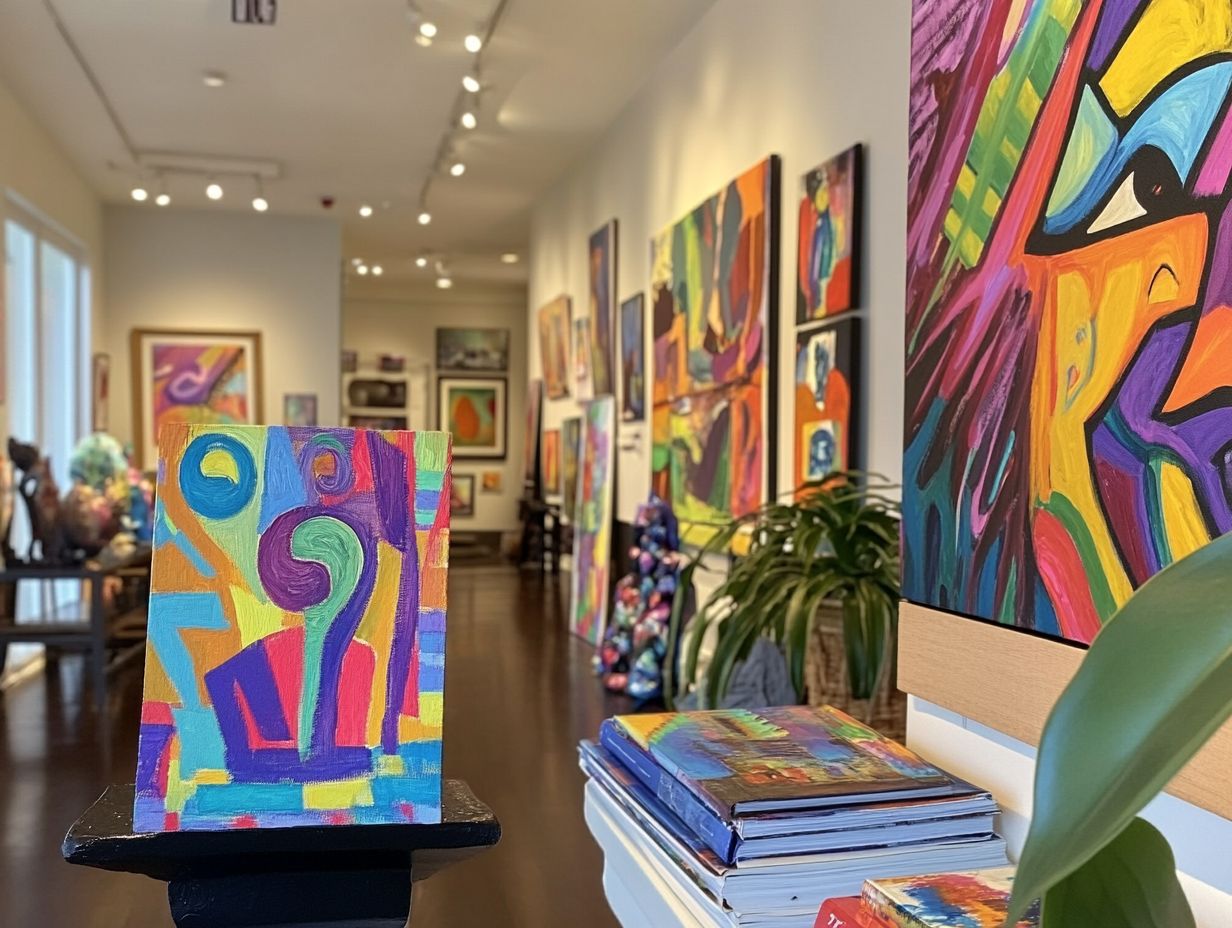
“El arte es una herramienta poderosa para la autoexpresi n y la comunicaci n, y es responsabilidad de los coleccionistas de arte compartir eso con el mundo.” – Elbert Hubbard
“No importa tu nivel de experiencia, cualquiera puede convertirse en coleccionista de arte y apreciar la belleza y el valor del arte.” – Ralph Waldo Emerson
“Coleccionar arte no se trata solo de poseer piezas valiosas, sino tambi n del viaje de descubrimiento y crecimiento personal que conlleva.” – Marina Abramovic
1. “Art is not what you see, but what you make others see.” – Edgar Degas
Edgar Degas once profoundly stated, “Art is not what you see, but what you make others see,” highlighting the importance of telling stories visually in your artistic journey. This quote beautifully encapsulates the essence of art collecting, where creation goes beyond mere aesthetics to forge a deeper connection with the human spirit.
As an art collector, you interpret these visual languages in uniquely personal ways. You often find yourself captivated by the intricate stories and emotional depth that artists convey.
Take Degas, for instance. His ability to capture movement and intimacy, especially in his ballet scenes, resonates with you on multiple levels. You don t just admire the technical skill; you see echoes of your own experiences and emotions reflected back at you.
This emotional investment transforms your art collecting into an important conversation, where each piece serves as a repository of feelings and memories. Through these connections, the act of collecting transcends the transactional.
It evolves into an enduring relationship where artworks embody timeless stories and shared human experiences, enriching your life’s narrative.
2. “The purpose of art is to make the invisible visible.” – Paul Klee
According to Paul Klee, “The purpose of art is to make the invisible visible,” highlighting how art serves as a bridge for expressing those abstract ideas and emotions that often slip through the cracks of verbal description.
His innovative approach has left a profound mark on modern art, urging you to delve into the depths of feelings and thoughts that can be challenging to articulate. Klee’s works are a testament to this transformation, turning those unseen concepts into vibrant visual expressions.
Through the masterful use of color, shape, and form, he communicates layers of deeper meaning. This ability to evoke emotional responses is vital; it enhances your engagement and appreciation of the artwork.
By making the unseen visible, Klee not only fosters a richer understanding of emotion in art but also invites you to forge an intimate connection with the artist’s inner world.
3. “Every artist was first an amateur.” – Ralph Waldo Emerson
Ralph Waldo Emerson wisely remarked, “Every artist was first an amateur,” a gentle reminder that your artistic journey begins with exploration and self-expression.
This journey is often filled with trials and errors, where you learn to navigate your unique creative landscape. Embracing your amateur status is essential, as it grants you the freedom to experiment without the weight of perfection pressing down on you.
Take, for instance, the illustrious careers of painters like Pablo Picasso and Vincent van Gogh. They started with basic techniques, gradually evolving their styles through bold exploration. Each brushstroke they made carried a risk, yet they dared to push boundaries, ultimately reshaping the art world.
By valuing their early, sometimes awkward efforts, they transformed into pioneers of their craft. This serves as a powerful reminder that growth often emerges from vulnerability and an eagerness to learn.
You can start your journey today!
4. “Art is not a handicraft; it is the transmission of feeling the artist has experienced.” – Leo Tolstoy
Leo Tolstoy once proclaimed, “Art is not a handicraft; it is the transmission of feeling the artist has experienced.” This powerful statement underscores how true art transcends mere technique, embedding itself in emotional connections and artistic value.
This perspective invites you, whether you re an artist, an audience member, or a collector, to engage deeply with the emotional narratives that each piece conveys. Dive into these emotional narratives! Storytelling, an essential element of art, enriches cultural experiences and makes them resonate on a personal level.
By viewing art through this emotional lens, you can cultivate a deeper appreciation for the pieces you acquire. Their value lies not just in their aesthetics or status, but in the shared human experience they embody. This emotional investment fosters a richer relationship between you and the artwork, transforming each piece into a vital link in the continuum of cultural storytelling.
5. “Art is not a thing; it is a way.” – Elbert Hubbard
Elbert Hubbard’s assertion that “Art is not a thing; it is a way” perfectly captures the essence of art as an ongoing adventure, a creative journey that transcends mere creation.
For you, as an art collector, this perspective likely serves as a guiding principle. It fuels your passion and reflects a profound appreciation for how art changes over time. Each piece in your collection tells a story, not just about the artist’s intent but also about your own experiences and growth.
Consider a fellow collector who joyfully recalls discovering a lesser-known artist at a local fair. This moment not only enriched their collection but also sparked a personal connection to the vibrant narrative behind the work. What stories do your favorite pieces tell you?
As you engage with innovative projects that push boundaries, you may increasingly recognize that your journey is not solely about acquiring beautiful objects. Engaging with innovative projects pushes boundaries. You ll see that your journey is more than just collecting beautiful objects; it s about actively participating in a larger dialogue surrounding creativity and transformation within the art world.
6. “The aim of art is to represent not the outward appearance of things, but their inward significance.” – Aristotle
Aristotle once said, “The aim of art is to represent not the outward appearance of things, but their inward significance.” This idea invites you, as a collector, to seek the emotional resonance and artistic inspiration embedded in each piece.
Approaching art with this perspective allows you to explore the rich narratives intertwined within contemporary works. You gain a deeper appreciation of how artists convey complex themes and emotions.
Take, for example, the works of Kehinde Wiley and Cindy Sherman. They not only challenge traditional aesthetics but also generate insightful conversations about identity and representation. Wiley’s vibrant portraits reimagine historical narratives, infusing them with contemporary relevance. Meanwhile, Sherman s conceptual photography encourages you to delve into the multifaceted nature of self and society.
By embracing the inward significance of these artworks, you can curate a collection that speaks to you personally, showcasing pieces that tell captivating stories and inspire deep reflection.
7. “Art is a journey of discovery.” – Marina Abramovic
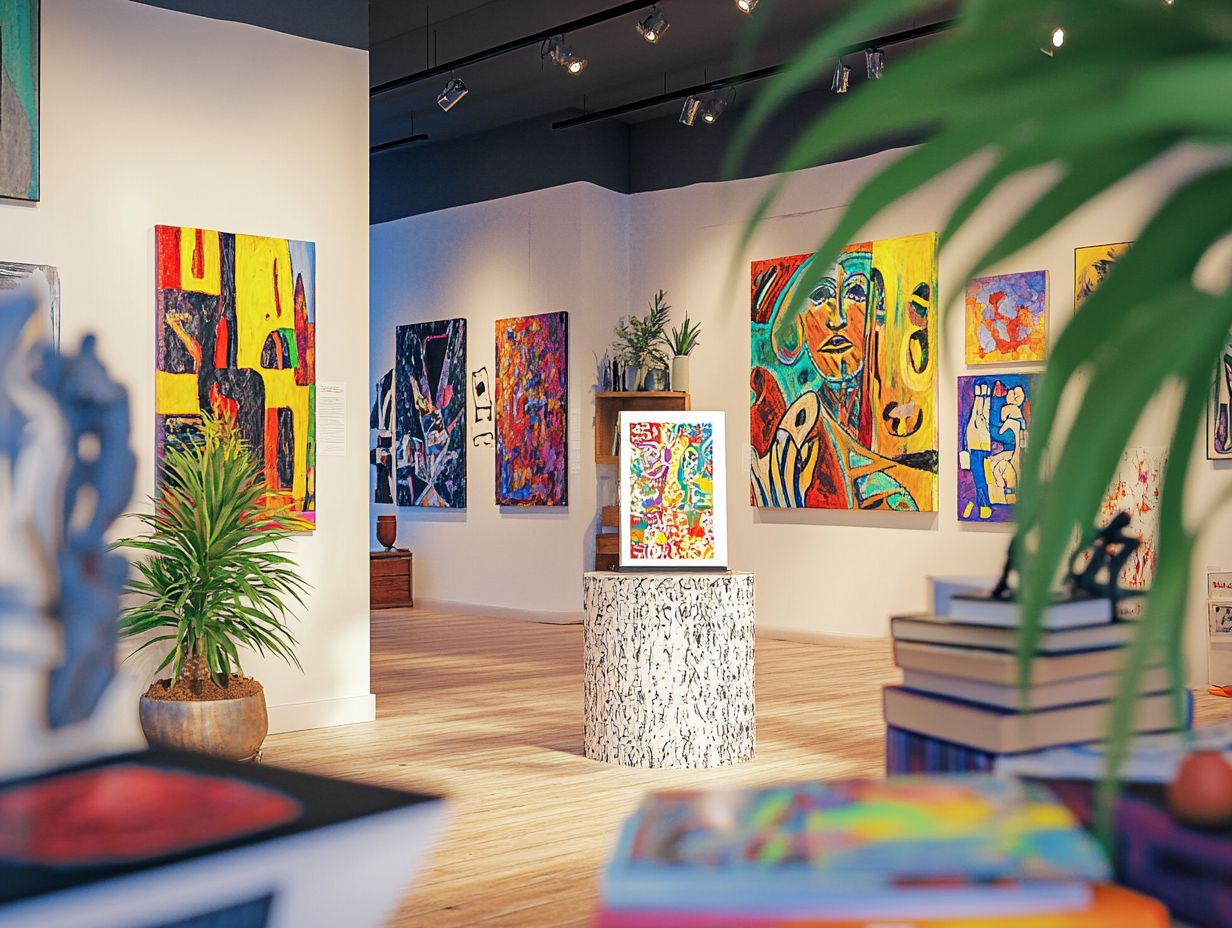
Marina Abramovic once stated, “Art is a journey of discovery,” emphasizing art’s remarkable ability to foster personal growth and exploration.
Through her performances, she invites you to confront your deepest fears and desires, opening pathways to a richer understanding of what it truly means to be human. This connection transcends simple observation; it transforms into an emotional dialogue, encouraging you to reflect on your own life and experiences.
When collectors engage with her work, they often find themselves doing more than just acquiring art they become part of a larger narrative that weaves together themes of vulnerability, resilience, and shared experiences. Each interaction becomes a chapter in this artistic odyssey, enriching their understanding of the artwork and, ultimately, themselves.
8. “Art enables us to find ourselves and lose ourselves at the same time.” – Thomas Merton
Thomas Merton once said, “Art enables us to find ourselves and lose ourselves at the same time,” highlighting the dual nature of art as both a personal journey and a communal experience.
This delicate mix is skillfully woven into the fabric of artistic expression, where your individual path merges with the shared stories of others.
Creation becomes a mirror that reflects your thoughts and connects you to your audience.
As a collector, you navigate these complexities, discovering joy in the solitary pleasure of your reflections and the vibrant conversations sparked with fellow enthusiasts who appreciate similar works.
In this manner, art transforms into a rich tapestry, interlaced with diverse interpretations, fostering an exchange that enhances the understanding of beauty in all its myriad forms.
9. “El arte no es lo que ves, sino lo que haces que otros vean.” – Edgar Degas
Reiterando a Edgar Degas, “El arte no es lo que ves, sino lo que haces que otros vean” encapsula bellamente la esencia de la expresi n art stica como un catalizador para el di logo y la conexi n emocional.
This statement emphasizes how visual languages woven through color, form, and composition can provoke deep reactions in you.
Take Vincent van Gogh, for example; his vibrant tones and dynamic brushstrokes capture the tempest of his emotions, inviting you to delve into his internal struggles.
Similarly, consider the surreal imagery and rich symbolism of Frida Kahlo. They communicate her pain and identity with surprising clarity, allowing you to forge a deeper connection.
These examples illustrate that visual elements do more than simply adorn; they engage and provoke reflection, nurturing a shared emotional experience between the artwork and you, the observer.
10. “Creativity takes courage.” – Henri Matisse
Henri Matisse wisely remarked, “Creativity takes courage,” highlighting the boldness necessary to embrace artistic risks and embark on innovative projects.
Courage stands out in the journeys of art collectors who bravely navigate the uncharted waters of unconventional artworks.
For instance, consider the daring choices made by collectors who champion artists like Ai Weiwei, whose provocative installations challenge societal norms, or Yayoi Kusama, whose vibrant, immersive exhibits invite you to confront your own perceptions of reality.
By supporting such innovative creators, you not only acquire unique works but also contribute to a dynamic dialogue within the art community, inspiring others to take similar risks.
As people increasingly appreciate boundary-pushing art, it creates an exciting environment where “creativity” becomes synonymous with “courage,” motivating future generations of artists and collectors to embrace their own daring paths.
Don’t miss out on the chance to support innovative creators! Join the movement and explore your own creative journey today!
What Makes Art Collecting Such a Unique and Fulfilling Hobby?
Art collecting is more than just a hobby; it s a unique blend of emotional connection and artistic inspiration, offering potential for financial investment and personal growth.
For you, curating a collection can be a powerful means of self-expression, deepening your appreciation for creativity and craftsmanship. You may find yourself captivated by the stories behind each piece, forming an intimate bond that goes beyond mere aesthetics.
As you navigate the vibrant landscape of the art world attending galleries, participating in auctions, and engaging with artists and fellow collectors you immerse yourself in a dynamic community experience.
Your journey through art collecting will be uniquely yours, shaped by your personal tastes and experiences, leaving a lasting impact on your life while enriching the broader narrative of artistic legacy.
What Are the Different Types of Art Collectors?
You ll find a diverse array of art collectors, each offering a distinct perspective that enriches the art world and enhances the cultural fabric of the artistic community.
These collectors typically fall into three main categories: amateur, institutional, and speculative.
- Amateur collectors are driven by personal passion and enjoyment. They dive deep into the narratives and emotions that each piece evokes.
- Institutional collectors represent museums, galleries, or organizations committed to preserving and promoting art. They shape public access and appreciation.
- Speculative collectors are those who buy art mainly for profit. They influence market dynamics and occasionally set trends.
Each of these groups plays a crucial role in the evolution of art movements, leaving a lasting legacy in their wake.
How Can One Start Building Their Own Art Collection?
Starting your art collection is exciting and rewarding! It invites you to appreciate art deeply, invest emotionally, and express your unique perspective.
As you embark on this journey, exploring various styles and mediums is essential to uncover what truly resonates with you. Don t wait! Start exploring local galleries today to find pieces that speak to you.
Begin by visiting local galleries, museums, and online platforms. Immerse yourself in a rich tapestry of diverse artworks. Setting a budget is equally important; by determining how much you re willing to spend, you ensure that your passion for art doesn t compromise your financial comfort.
Engaging in art events, like exhibitions and fairs, expands your knowledge while opening doors to valuable networking opportunities with fellow collectors and artists. Over time, as new pieces find their way into your collection, a unique emotional bond develops, turning each artwork into a cherished story waiting to be unveiled.
What Are the Benefits of Owning and Collecting Art?
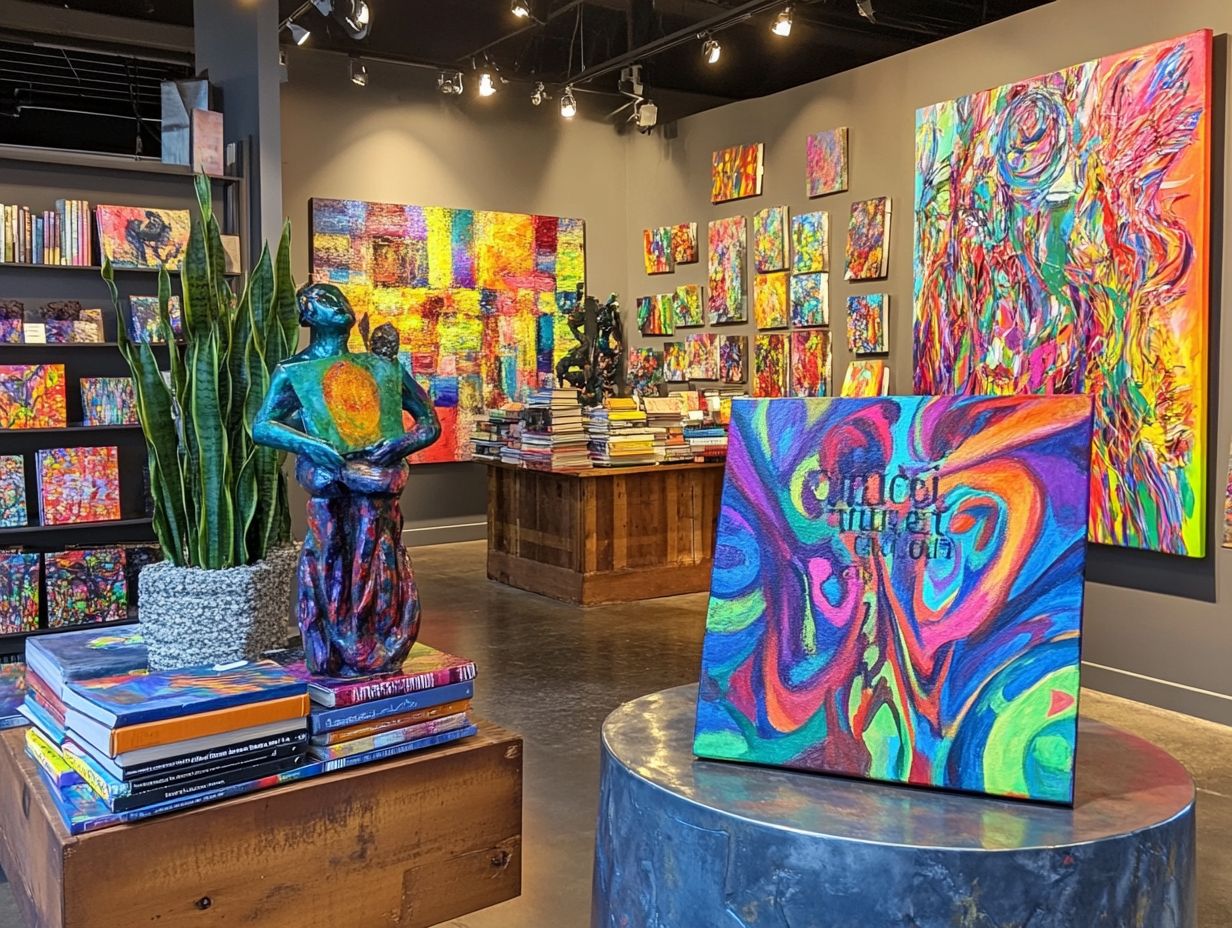
Owning and collecting art presents a wealth of benefits. It enhances your quality of life, serves as a savvy financial investment, and provides cultural significance.
For many, the journey of art collecting goes beyond just buying art; it becomes a deep emotional engagement. Each carefully selected piece infuses joy and prompts introspection through daily existence. This passion allows you to forge deeper connections with artistic expression and cultivate a richer understanding of cultural narratives and artistic value.
Consider the remarkable journey of renowned collectors like Eli Broad. Their unwavering commitment to contemporary art helps them build a respected collection while supporting public art institutions.
By investing in art, you also become an advocate for the arts, fostering a shared cultural legacy that future generations will cherish.
What Are the Challenges of Being an Art Collector?
Art collectors often find themselves navigating a landscape filled with emotional connections, artistic risks, and the challenge of making smart buying choices. These hurdles can make your journey difficult.
The ever-changing art market doesn t always reflect a piece s true value, leaving you unsure about its future worth. Questions of authenticity can creep in, making it difficult to shake off the fear of acquiring a forgery.
Emotional dilemmas also come into play, especially when your attachment to a work clashes with prevailing market trends. You can tackle these challenges with practical strategies:
- Build strong relationships with reputable galleries.
- Invest time in educating yourself about the art world.
- Maintain a clear focus on your personal passion rather than merely chasing financial gain.
Understanding the art landscape can help you navigate these complexities with greater confidence.
Ready to start your art journey? Dive in today!
How Can Art Collectors Support and Contribute to the Art World?
Art collectors are essential to the art world. They enhance its visibility, invest emotionally, and nurture a vibrant artistic community.
When you attend gallery openings and exhibitions, you’re not just indulging your passion; you’re also elevating the profiles of both emerging and established artists.
By participating in fundraising events, you contribute valuable financial support. You also champion initiatives that promote the ways artists share their ideas.
Your involvement can spark awareness. This can inspire others to recognize the significance of art and its profound impact on society.
Ultimately, you play a crucial role in cultivating an environment where creativity can truly thrive.
What Are the Most Valuable Pieces of Art in the World?
The realm of art collecting is home to some extraordinary pieces. Each embodies significant cultural importance, artistic legacy, and the potential for lucrative financial returns.
Consider masterworks like Leonardo da Vinci’s “Salvator Mundi” or Edvard Munch’s evocative “The Scream.” These artworks transcend mere aesthetic appeal and encapsulate the dominant art movements of their periods.
Da Vinci s piece beautifully intertwines Renaissance ideals with a mystique that captivates audiences today. Munch s iconic exploration of existential angst resonates deeply within modern psychology, influencing countless artists along the way.
Each artwork you encounter contributes uniquely to the rich tapestry of art collecting. These pieces stand as a testament to the evolving values of society while offering profound insights into the historical contexts from which they emerged.
What Are the Common Misconceptions About Art Collecting?
Misconceptions about art collecting often lead people to believe it s solely a pursuit for the wealthy. This overshadows the emotional engagement and appreciation that anyone can cultivate.
Many think that only high-value art deserves attention. This misses the vibrant community of artists and collectors who treasure pieces for their storytelling and personal significance rather than their market price.
Experienced collectors will tell you that art collecting isn t just about making a monetary investment. It s a journey driven by passion and connection.
With accessible avenues from local art fairs to online platforms, you can explore and support emerging talents, regardless of your background.
This inclusive spirit creates a sense of belonging. It proves that anyone can play a part in the rich tapestry of the art world.
What Are Some Inspirational Quotes from Famous Art Collectors?
Famous art collectors often share inspirational quotes that reveal their emotional connections and artistic journeys throughout their collecting experiences. For more insights, you can check out 5 art collectors to follow for inspiration, which provide a window into the motivations and passions that drive individuals in their pursuit of artistic treasures.
Some collectors describe art as a mirror of their identity. Others highlight the transformative nature of engaging with diverse artistic expressions.
By looking into these reflections, you whether a novice or a seasoned collector can uncover invaluable lessons about the significance of forging personal relationships with art. Embrace new ideas and appreciate the narratives that each piece holds.
This deeper context not only enhances your collecting experience but also nurtures a richer appreciation for the creative minds behind the artworks.
How Can Art Collectors Continue to Grow and Evolve in Their Hobby?
Now is the perfect time to grow and evolve in your art collecting journey. Explore new artistic expressions, engage with the vibrant artistic community, and invest in innovative projects.
By immersing yourself in a variety of workshops and discussions, you deepen your understanding of art history and contemporary trends.
Joining local art groups allows you to connect with like-minded individuals. This offers valuable insights and encouragement along the way.
Diversifying your collection not only enhances its aesthetic appeal but also broadens your knowledge. Each piece you collect tells a unique story, inviting you to delve deeper into different mediums and styles.
This ongoing journey of artistic exploration enriches your collection. It nurtures a profound appreciation for the transformative power of art.
Frequently Asked Questions
What piece will you discover next?
What is the significance of collecting art?
Collecting art helps us appreciate talented artists and supports cultural heritage. It creates a personal connection with each piece.
How can 10 inspirational quotes benefit art collectors?
Inspirational quotes motivate and provide insight for collectors, reinforcing the importance of understanding 5 things every art collector should know. They deepen appreciation for both the pieces and the art world.
Who are some notable figures that have expressed the importance of art collecting?
Pablo Picasso, Vincent van Gogh, and Andy Warhol each emphasized the importance of art collecting. Their words continue to inspire collectors today.
What is the role of inspiration in art collecting?
Inspiration is key when building a collection. It helps collectors choose pieces that resonate with their tastes and passions.
How can these quotes enhance the art collecting experience?
These quotes guide and motivate collectors, encouraging exploration of new artists and a deeper understanding of the art world. For those interested, checking out the 10 must-visit museums for art collectors can provide further inspiration.
What is the best way to apply these quotes to my own art collecting journey?
Reflect on the meanings behind the quotes. Use them as inspiration to shape your unique collection.

